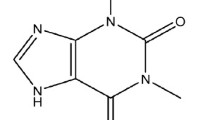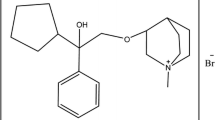Summary
The effect of ipriflavone and its major metabolites, 7-hydroxy-isoflavone and 7-(1-carboxy-ethoxy)-isoflavone on theophylline metabolism was examined in vitro in human liver microsomes. The compounds inhibited the N-demethylation to 1- or 3-methylxanthine, the major pathway of theophylline metabolism. The effect showed concentration dependence. The oxidation of theophylline to 1,3-dimethyluric acid was slightly affected by ipriflavone and its metabolites and the effect was non-specific. Results indicate that the reduction of theophylline clearance by concomitant ipriflavone administration observed by Takahashi et al. [Takahashi J., Kawakatsu K., Wakayama T., Sawaoka H. (1992): Elevation of serum theophylline levels by ipriflavone in a patient with chronic obstructive pulmonary disease. Eur. J. Clin. Pharmacol., 43, 207–208] is primarily due to an interaction of the inhibitory ipriflavone and/or its metabolites with cytochrome P450 enzyme(s) that mediate N-demethylation of theophylline.
Similar content being viewed by others
References
Yamazaki I., Kinoshita M. (1986): Calcium secreting property of ipriflavone in the presence of estrogen. Life Sci., 38, 1535–1541.
Takahashi J., Kawakatsu K., Wakayama T., Sawaoka H. (1992): Elevation of serum theophylline levels by ipriflavone in a patient with chronic obstructive pulmonary disease. Eur. J. Clin. Pharmacol., 43, 207–208.
Monostory K., Vereczkey L. (1995): Interaction of theophylline and ipriflavone at cytochrome P450 level. Eur. J. Drug Metab. Pharmacokinet., 20, 43–47.
van der Hoeven T.A., Coon M.J. (1974): Preparation and properties of partially purified cytochrome P-450 and reduced nicotinamide adenine dinucleotide phosphate-cytochrome P-450 reductase from rabbit liver microsomes. J. Biol. Chem., 249, 6302–6310.
Lowry H., Rosebrough N.J., Farr A.L., Randall R.J. (1951): Protein measurement with Folin phenol reagent. J. Biol. Chem., 193, 265–275.
Robson R.A., Miners J.O., Matthews A.P., et al. (1988): Characterisation of theophylline metabolism by human liver microsomes. Biochem. Pharmacol., 37, 1651–1659.
Hamasaki Y., Ichimaru T., Miyazaki S. (1986): A micromethod for measuring theophylline and the metabolites in serum by reverse phase high pressure liquid chromatography. Jpn. J. Clin. Chem., 15, 44–50.
Author information
Authors and Affiliations
Rights and permissions
About this article
Cite this article
Monostory, K., Vereczkey, L. The effect of ipriflavone and its main metabolites on theophylline biotransformation. European Journal of Drug Metabolism and Pharmacokinetics 21, 61–66 (1996). https://doi.org/10.1007/BF03190279
Received:
Issue Date:
DOI: https://doi.org/10.1007/BF03190279




